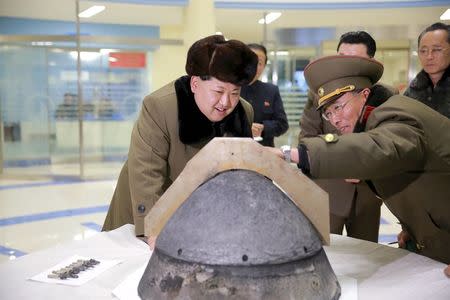Fresh activity seen at North Korea nuclear site - U.S. think tank

WASHINGTON (Reuters) - A U.S. research institute said on Friday it had seen fresh activity in satellite images of North Korea's main nuclear complex, suggesting that reprocessing may be underway to produce more plutonium for atomic bombs. A report this month on the 38 North website run by the Johns Hopkins University's School of Advanced International Studies said exhaust plumes had been detected from the thermal plant at Yongbyon's Radiochemical Laboratory, the site's main reprocessing installation to produce plutonium. On Friday, a new 38 North report said more recent imagery showed a loaded railroad flatcar at the Radiochemical Laboratory, excavation alongside a building used to store waste from earlier reprocessing and excavation work at the cooling water cistern of the site's Experimental Light Water Reactor. It said the activity was consistent with a Feb. 9 assessment by the director of U.S. National Intelligence, James Clapper, who said North Korea could begin to recover plutonium from spent fuel "within a matter of weeks to months" and indicated that it "has already begun or plans to commence a reprocessing campaign to separate additional plutonium for nuclear weapons." The report said the flatcar was loaded with what appeared to be four rectangular tanks, or casks, which could be used for chemicals used in reprocessing, or to remove waste products. "Loaded railcars have only been observed here on a few rare occasions in the early 2000s, all associated with a reprocessing campaign," it said. The prospect of North Korea acquiring more plutonium will be looked on with concern by the United Nations Security Council, including Pyongyang's sole major ally, China. The council agreed to tough new sanctions on North Korea after it conducted its fourth nuclear test on Jan. 6 and a long-range rocket launch a month later. The latest 38 North report comes hours after North Korea attempted and failed to launch what experts believe was an intermediate-range ballistic missile, and amid concerns that it may attempt a fifth nuclear test. On Wednesday, 38 North said satellite imagery from April 11 showed activity at North Korea's Punggye-ri nuclear test site and that the possibility of a fifth nuclear test "could not be ruled out." 38 North predicted in February last year that North Korea's nuclear weapons stockpile could grow to 20, 50 or 100 bombs within five years, from an estimated 10 to 16 weapons at that time. (Reporting by David Brunnstrom; Editing by James Dalgleish)

